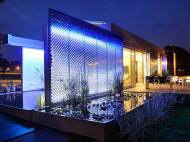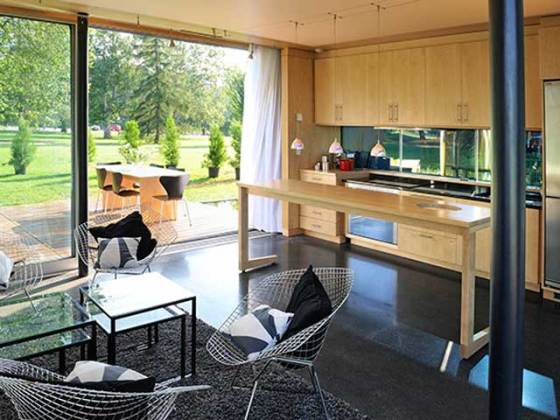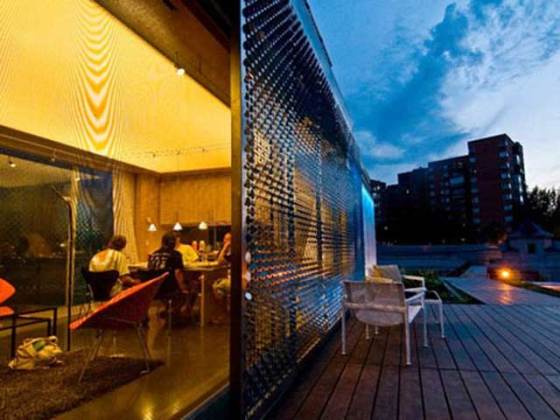Green architecture – LUMENHAUS
 Although we tend not to write about prefabricated homes, here is an article about a house that was recently exhibited in Millennium Park, Chicago. Inspired by the glass pavilion-style Farnsworth House designed by Bauhaus architect Mies Van Der Rohe, the folks from Virginia Tech came up with LUMENHAUS – a prefabricated house which features a flowing, open plan that connects occupants to each other within the house and to nature outside.
Although we tend not to write about prefabricated homes, here is an article about a house that was recently exhibited in Millennium Park, Chicago. Inspired by the glass pavilion-style Farnsworth House designed by Bauhaus architect Mies Van Der Rohe, the folks from Virginia Tech came up with LUMENHAUS – a prefabricated house which features a flowing, open plan that connects occupants to each other within the house and to nature outside.
The concrete floor houses a radiant floor heating system. The system heats the house by means of a water-to-water heat pump that extracts heat from the earth in the winter and uses the earth as a coolant in the summer. This geothermal heat pump system also produces free hot water as a byproduct during its summertime operation.
LUMENHAUS is completely powered by the sun. A powerful array of Photovoltaic (PV) panels provides carbon-neutral energy to the house. The photovoltaics are arranged in a single array that covers the roof. The panels are bifacial, meaning they use both sides to increase energy output by up to 15 percent. Using an electric actuator, the entire PV array can be tilted to the optimal angle for each season (from zero degrees to a 17-degree angle in summer and to a 35-degree angle in winter).
The energy collected during the day will be symbolically radiated back out at night through LED lighting system which is built right into the insulating panels of the Eclipsis System and throughout the house in strategic spots. The Eclipsis System is an advanced building façade comprising two layers – a metal shutter shade and a translucent insulating panel. The shutter shade slides along the north and south façades, providing protection from direct sunlight while simultaneously allowing abundance of indirect natural lighting, views to the exterior and privacy to those inside.
The house has a computer interface that manages all of its systems. Many aspects of these systems can be controlled by the user, at home or remotely, through either a computer or a smartphone. For example, you could easily turn on and off lights, relocate the Eclipsis System, lock or unlock your front door, change the temperature or lighting in the car on the way home after a hard day at the office so you can just relax when you walk in the door. The management system gives live feedback of the house’s energy consumption, allowing you to be more energy conscious and to easily make changes to be more efficient.
The roof is sloped to collect rainwater that is filtered for potable (drinkable) use in the house, while water used in the house (greywater – from the shower, bathroom sink and clothes washer) goes through a series of bio-filters in the surrounding landscape where it is cleaned for non-potable use. The wood decking around the house has been harvested from fast-growth, sustainable forests. The concrete floor, which collects heat in the winter, contains recycled fly ash, while the translucent insulation panels on the north and south façades have an R-value equal to that of a typical solid wall. The zinc cladding and aluminum framing on the exterior of the house are extremely durable and recyclable.
Natural ventilation is the ventilation/cooling of the house through means other than mechanical/electrical-powered systems. The house can be naturally cooled and ventilated by opening any of the sliding doors on the north and side façade of the house. These doors include bug screens to keep bugs out of the house and to let in fresh, clean air. The modular design of LUMENHAUS allows connection of multiple units, which are stackable with plug-in stairs and entryways to create two-, three-, and four-bedroom houses with the same efficient use of space of the single module.
An innovative transportation system allows the house to be transported easily without expensive permitting and very little on-site construction or assembly. The system, which is inspired by the double-drop lowboy trailer, is made up of removable and reusable components (axle/wheel assembly on the back and hitch hookup on the front) allowing for simple truck transport, flexible suspension and higher height clearances than conventional modular transport methods. The house’s strong steel structural frame supports it while in transit.











Leave your response!